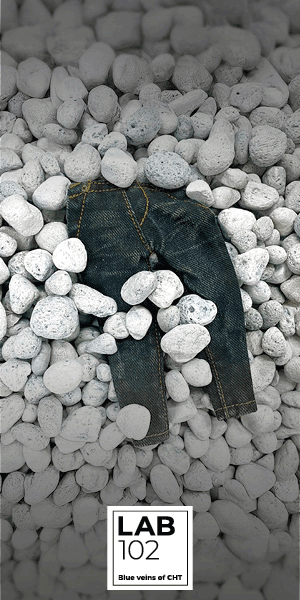Stretch in or out?

Jeans are near perfect candidates for mechanical recycling thanks to their high cotton content. But the presence of elastane, nearly as ubiquitous, can be a stumbling block for circularity. Luckily, workarounds are being found as are new solutions to recycle the stretch fibre.
Present in minor concentrations in jeans, elastane or spandex, as it is also called, plays a major role in fit, comfort and longevity. While looser-fitting jeans are back on trend, they have not dampened demand for stretchy skinny styles. They are here to stay as is a measure of give for comfort. A few forward-thinking brands are taking the bold move to limit the use of stretch fibres in their ranges.
Over the years, elastane has been the go-to solution to offer comfort and fit. Matter to Market, a consultancy specialising in bringing next-gen fibres to market, screens the presence of fibre use in apparel, drawing on data collected by Edited, a London-based retail intelligence platform. Its report on clothing sold online in the UK found elastane to be present in 34% of the millions of items scanned. For jeans, the proportion is higher, 52% of them mention the stretch fibre on care and composition labels.
A measure of stretch drives sales and, consequently, market share. However, when jeans reach the end of their useful life and could be recycled to make new ones, the presence of spandex is no longer a benefit. It may deliver added value for retailers, but it is considered a contaminant by recyclers.
The mechanical recycling of jeans is a multistep process that starts with collecting and sorting suitable feedstock before garments are chopped, shredded, and combed back into fibres. The shredding is the hot spot here as elastane forms a spiderweb-like substance that clogs the machines. Recyclers can accept a certain amount of ‘other fibres’ in their mix, and usually set the bar at 5% for spandex. At this level, a fabric can be recycled, but the value of the recycled fibres may be lower.
As textile-to-textile recycling facilities scale up and adoption of automated sorting systems grows, stretch jeans pose yet another challenge. The elastane yarns in denim fabrics are often corespun, meaning they are covered by a layer of cotton. The near-infrared sensors used by automated sorting machines will not be able to detect the presence of the hidden spandex. Here again, it may contaminate feedstock for both mechanical and chemical recyclers.
Circular denim advocates
A few circular-minded denim brands are taking measures to use elastane ‘with purpose’ and reduce its presence to the lowest possible level. Mud Jeans, a pioneer in recycled cotton and circular business models, from leasing to reselling, says that its recyclers can accept a 5% maximum of foreign fibres. "Ideally, of course, we use less, and our aim is to use a maximum of 2%,” Dion Vijgeboom, the brand's head of product, tells Inside Denim. Looking to limit its use of stretch fibres, the brand is now offering jeans made from a new 100% cotton fabric (20% post-consumer recycled, 80% organic) engineered to offer a mechanical elasticity of approximately 10% due to specific spinning and weaving parameters. This, he says, is the “ultimate natural stretch solution”.
Swedish brand Nudie Jeans is taking a similar path. It has broadened its offering of regular and loose-fit jeans in the last couple of years and has thus gradually decreased its dependence on elastane. “Raw and rigid denim is our core, but we also have deep roots in the slim and skinny drawers, making elastane use in denim fabric a necessity to a certain degree,” says Kevin Gelsi, circular product manager for Nudie Jeans. “As long as we have slim or skinny fits in our assortment, a slight use of elastane or alternative stretch fibres will remain necessary and relevant. We’ve never been keen to use elastane, or other stretch fibres, if it doesn’t deliver this essential wearer comfort.” In general, the premium denim label has limited the use of elastane to no more than 2-3%. “When considering the needs of our denim fabric suppliers that can mechanically recycle our jeans, a maximum of 3% elastane is acceptable for good recycling results, without compromising quality and durability,” he adds.
Denim Deal knows a thing or two about jeans recycling. The initiative, born in the Netherlands, has now set up hubs in France, Germany and India with local suppliers. Its mission is to increase uptake of post-consumer recycled cotton with a stated goal of reaching one billion pairs of jeans made from at least 20% recycled content. It is no surprise that the organisation recommends limiting the use of elastane. Its presence “is a crucial component for ensuring the fit and comfort of jeans and for developing a diverse range of styles to meet consumer demand,” says Nicolas Prophte, a member of the Denim Deal’s steering committee. He agrees, however, that “there is broad technical consensus within the mechanical recycling industry that up to 5% elastane content is manageable for fibre removal, allowing the fabric to be recycled without contamination”. Denim Deal members have access to technical guidelines to maximise the recyclability of jeans at the end of their useful life, and this includes the exclusion of polyester fibres.
Possible glitches
Pakistan-based denim mill Neela by Sapphire (NBS) has been working with recycled cotton in a partnership with Recover, a company specialising in pre- and post-consumer recycled cotton yarns. They created a circular concept collection that leads to significant processing savings, including avoiding dyeing, while maintaining core denim aesthetics, the company says. The collection features rigid and comfort stretch fabrics containing no more than 1% elastane. Zeeshan Ahmed, head of product development for NBS says that when using 15% to 20% Recover recycled content in a fabric made from recycled fibres which contain 1–2% elastane, there are generally no issues with indigo-dyed fabrics. “From my experience, 1% elastane does not significantly impact the appearance of indigo fabrics. However, when it comes to black fabrics, and especially black-over-black, there is a possibility that elastane particles may become visible on the fabric surface,” he tells Inside Denim.
Elastane producers on board
Producers of elastane yarns, such as The Lycra Company and Hyosung, are well aware of these issues, and are also deeply committed to a more sustainable apparel industry. Both companies are working with recyclers to investigate new methods that can process stretch fabrics and garments. “Most recyclers require feedstock that is 100% cotton, polyester or nylon. Yet this does not reflect the reality of textile waste,” points out Dr. Alberto Ceria, a textile and chemical engineer at The Lycra Company’s R&D department. He admits that “elastane is everywhere” but insists that “its value is overlooked”. He argues that it should not be considered a contaminant, as it is always used for a reason. “Without it, a fabric may not have been made in the first place.” He believes that retrieving the stretch fibre would increase a recycler’s yield, making its business more sustainable and economical. But what may be true for swimwear, which are made from fabrics with a high percentage of elastane, does not apply to denims. To optimise yields and enable manufacturers of elastane to retrieve recycled material, the more elastane recovered, the better. “In clothing with low elastane content, we understand that it will often be lost,” he concedes.
Korean textile conglomerate Hyosung, the world’s largest elastane producer, is also working with recyclers and investigating both post-industrial and post-consumer waste. At this stage of development, the learning curve is wide open, and Hyosung is pursuing a hybrid strategy, says Simon Whitmarsh-Knight, Hyosung Textiles’ global sustainability manager. Due to the variety of fibres, additives and colourants, he does not foresee “a one-size-fits-all solution”. He also notes the critical importance of cost-efficiency. “No matter how advanced the technology may be, commercialisation is not viable unless the process can achieve acceptable levels of economic performance that the market is willing to support.”
Some recyclers have found solutions for elastane-embedded clothes. Re&Up, part of Turkey-based Sanko Group, says that its technology can handle post-consumer and post-industrial textile waste, including garments with elastane. “Our process is capable of identifying and extracting elastane,” Re&Up general manager Andreas Dorner tells Inside Denim. After an initial mechanical transformation, a thermo-chemical process separates the stretch yarn from other fibres. “This enables us to isolate components such as elastane, polyester and colourants, while preserving the integrity of the cotton fibres,” he says. The elastane is currently ‘downcycled’ in non-textile applications, such as in the automotive industry. But the company is working with elastane producers to explore pathways for integrating it back into circular textile systems. Mr Dorner notes that “on average, the elastane content in the material we process is around 3 to 4%”.
A matter of proportion?
Innovation in recycling processes could in time find ways to regenerate textile waste of all types, including those pesky stretchy ones. To phase out elastane from the initial design is clearly one option that could boost circularity in the denim industry.
The Circular Textile Foundation in the UK, an organisation founded by Tim Cross, who also established Project Re:Claim, a thermomechanical recycling facility for polyester, focuses specifically on the design stage and offers guidance and courses for designers and product developers. Having experience in developing “circular” products, Mr Cross has devised a simple “theory of thirds”. He believes that one third of clothing made today is already recyclable, but brands don not know this or take account of it. A second third is probably recyclable, if a few minor changes were made, without changing the aspect or performance of the garment. This could be as simple as reducing elastane content from 6 to 5%, and making pocket bags out of cotton instead of polyester. The final third will require” a massive redesign” or a “new recycling technology”. The Circular Textile Foundation has chosen to focus on the first two thirds, those that require little effort. “It is a revolution in thought, it does not require a new breed of designers. We can get there quickly,” he says.
Lutz Walter, a textile innovation expert, regular LinkedIn contributor, and secretary general of the European Technology Platform for the Future of Textiles and Clothing, dedicated a post to the issue of elastane and circularity. Recycling fabrics with elastane, he notes, is a matter of scale. “The feedstock recyclers are working with will contain no more than 3-5% elastane on average”, and “a recycler will only recover some 25-30% of the actual amount of the elastane in any valuable and reusable intermediate form”. This implies that a recycler will “need a lot of feedstock to create any useful volume” of recycled elastane. For the denim industry, where elastane is already used in low proportions, it may not be too difficult to reduce its presence by a few more notches.
Nudie Jeans’ repair shops and partners collect used jeans and pre-sort what can be resold as Re-use jeans, what can be used for redesign projects, and what can only can only be recycled into new fibre. In Europe, these are sent to the brand’s warehouse in Sweden and then shipped to its denim suppliers in Turkey for fibre-to-fibre recycling to use in the production of new Nudie Jeans denim fabric.
Photo: Nudie Jeans













